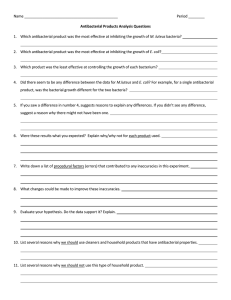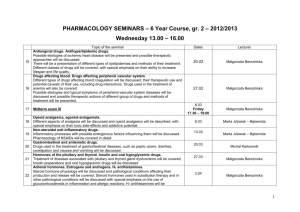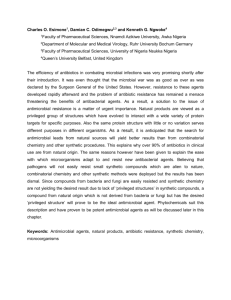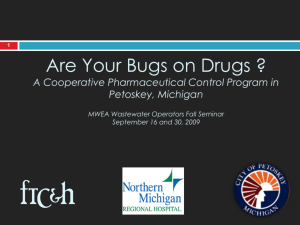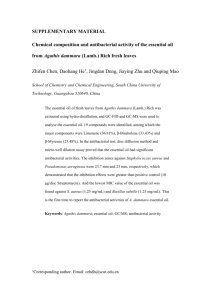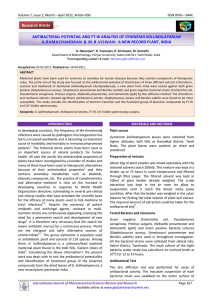Current Research Journal of Biological Sciences 5(2): 49-52, 2013
advertisement
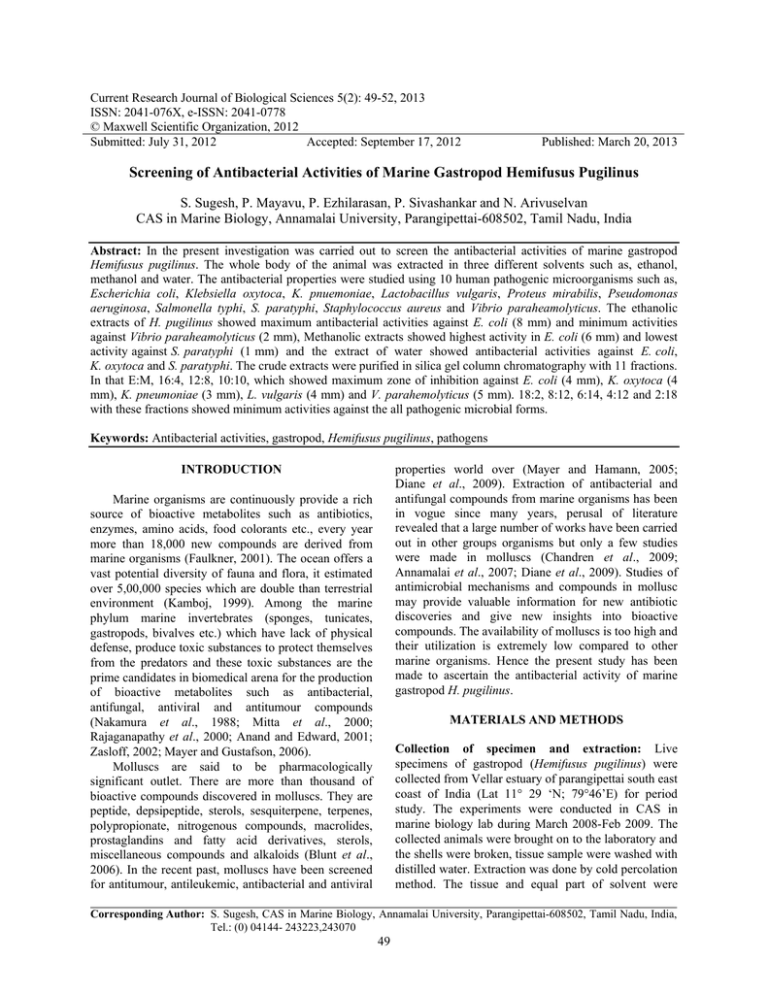
Current Research Journal of Biological Sciences 5(2): 49-52, 2013 ISSN: 2041-076X, e-ISSN: 2041-0778 © Maxwell Scientific Organization, 2012 Submitted: July 31, 2012 Accepted: September 17, 2012 Published: March 20, 2013 Screening of Antibacterial Activities of Marine Gastropod Hemifusus Pugilinus S. Sugesh, P. Mayavu, P. Ezhilarasan, P. Sivashankar and N. Arivuselvan CAS in Marine Biology, Annamalai University, Parangipettai-608502, Tamil Nadu, India Abstract: In the present investigation was carried out to screen the antibacterial activities of marine gastropod Hemifusus pugilinus. The whole body of the animal was extracted in three different solvents such as, ethanol, methanol and water. The antibacterial properties were studied using 10 human pathogenic microorganisms such as, Escherichia coli, Klebsiella oxytoca, K. pnuemoniae, Lactobacillus vulgaris, Proteus mirabilis, Pseudomonas aeruginosa, Salmonella typhi, S. paratyphi, Staphylococcus aureus and Vibrio paraheamolyticus. The ethanolic extracts of H. pugilinus showed maximum antibacterial activities against E. coli (8 mm) and minimum activities against Vibrio paraheamolyticus (2 mm), Methanolic extracts showed highest activity in E. coli (6 mm) and lowest activity against S. paratyphi (1 mm) and the extract of water showed antibacterial activities against E. coli, K. oxytoca and S. paratyphi. The crude extracts were purified in silica gel column chromatography with 11 fractions. In that E:M, 16:4, 12:8, 10:10, which showed maximum zone of inhibition against E. coli (4 mm), K. oxytoca (4 mm), K. pneumoniae (3 mm), L. vulgaris (4 mm) and V. parahemolyticus (5 mm). 18:2, 8:12, 6:14, 4:12 and 2:18 with these fractions showed minimum activities against the all pathogenic microbial forms. Keywords: Antibacterial activities, gastropod, Hemifusus pugilinus, pathogens properties world over (Mayer and Hamann, 2005; Diane et al., 2009). Extraction of antibacterial and antifungal compounds from marine organisms has been in vogue since many years, perusal of literature revealed that a large number of works have been carried out in other groups organisms but only a few studies were made in molluscs (Chandren et al., 2009; Annamalai et al., 2007; Diane et al., 2009). Studies of antimicrobial mechanisms and compounds in mollusc may provide valuable information for new antibiotic discoveries and give new insights into bioactive compounds. The availability of molluscs is too high and their utilization is extremely low compared to other marine organisms. Hence the present study has been made to ascertain the antibacterial activity of marine gastropod H. pugilinus. INTRODUCTION Marine organisms are continuously provide a rich source of bioactive metabolites such as antibiotics, enzymes, amino acids, food colorants etc., every year more than 18,000 new compounds are derived from marine organisms (Faulkner, 2001). The ocean offers a vast potential diversity of fauna and flora, it estimated over 5,00,000 species which are double than terrestrial environment (Kamboj, 1999). Among the marine phylum marine invertebrates (sponges, tunicates, gastropods, bivalves etc.) which have lack of physical defense, produce toxic substances to protect themselves from the predators and these toxic substances are the prime candidates in biomedical arena for the production of bioactive metabolites such as antibacterial, antifungal, antiviral and antitumour compounds (Nakamura et al., 1988; Mitta et al., 2000; Rajaganapathy et al., 2000; Anand and Edward, 2001; Zasloff, 2002; Mayer and Gustafson, 2006). Molluscs are said to be pharmacologically significant outlet. There are more than thousand of bioactive compounds discovered in molluscs. They are peptide, depsipeptide, sterols, sesquiterpene, terpenes, polypropionate, nitrogenous compounds, macrolides, prostaglandins and fatty acid derivatives, sterols, miscellaneous compounds and alkaloids (Blunt et al., 2006). In the recent past, molluscs have been screened for antitumour, antileukemic, antibacterial and antiviral MATERIALS AND METHODS Collection of specimen and extraction: Live specimens of gastropod (Hemifusus pugilinus) were collected from Vellar estuary of parangipettai south east coast of India (Lat 11° 29 ‘N; 79°46’E) for period study. The experiments were conducted in CAS in marine biology lab during March 2008-Feb 2009. The collected animals were brought on to the laboratory and the shells were broken, tissue sample were washed with distilled water. Extraction was done by cold percolation method. The tissue and equal part of solvent were Corresponding Author: S. Sugesh, CAS in Marine Biology, Annamalai University, Parangipettai-608502, Tamil Nadu, India, Tel.: (0) 04144- 243223,243070 49 Curr. Res. J. Biol. Sci., 5(2): 49-52, 2013 ground with motor and pestle. The slurry was filtered and washed to remove non soluble fractions. The filtered substance was centrifuged at 15000 rpm for 30 min. The extracts were condensed at 35°C, until the solvent gets evaporated and the final residue was used as a source of antimicrobial substance which used to subject the antimicrobial assay. eluted fraction was assayed with filter paper disc on antimicrobial assay. RESULTS Antibacterial activities of H. pugilinus were shown in Fig. 1 and 2. The gastropod exhibits antimicrobial property against all pathogens. Antibacterial activity of crude extracts: Antibacterial activity of the gastropods extracts were assessed using the standard agar diffusion method with 6 mm diameter whatman No. 1 filter paper discs (Becerro et al., 1994). Muller-Hinton agar was used for the antimicrobial assay. Before the antibacterial assay, the pathogenic bacterial forms (E. coli, K. axytoca, K. pnuemoniae, L. vulgaris, P. mirabilis, P. aeruginosa, S. typhi, S. paratyphi, S. aureus and V. paraheamolyticus) were inoculated into the nutrient broth and incubated at 37°C for 24 h. The pathogens were swabbed on Muller Hinton agar plates and filter paper disc (Jayaseeli et al., 2001) were impregnated in 50 µL of gastropods extracts were placed on the surface of agar plates. Control disc water and solvents were also placed on the agar plates to assess the effect of water and solvents on the pathogenic bacterial forms. The plates were incubated at 37°C for 24 to 48 h and the antibacterial activity was measured as diameter on zone of inhibition around the disc impregnated in gastropod extract. Antibacterial activities of crude extract: The ethanol extracts was showed maximum activity against E. coli (8 mm), K. pneumonae (5 mm), S. aureus (3 mm), P. mirabilis (2 mm) and minimum activity was observed against K. oxytoca (1 mm). L. vulagaris, P. aeruginosa and S. typhi were resistant to crude methanolic extract of gastropod Hemifusus pugilinus methanol extract. The methanol extracts of gastropods showed highest activity against E. coli (6 mm), K. pneumoniae (4 mm), K. oxyta (3 mm), L. vulgaris (3 mm), S. aureus (2 mm) and lowest activity against S. paratyphi (1 mm), V. paraheamolyticus (1 mm). Water extract of H. pugilinus did not show any activity against the bacterial strains barring E. coli where it showed activity. The result of present study also stated that P. aeruginosa and S. typhi were found resistant to all the three extracts of H. pugilinus. Antibacterial activity of partially purified extracts: The methanol and ethanol extracts were fractionally purified on column chromatography in silica gel (Anand and Edward, 2001). Elution was made on (18:2, 16:4, 14:6, 12:8, 10:10, 8:12, 6:14, 4:16 and 2:18). The Antibacterial activities of partially purified extract of Hemifusus pugilinus: The crude extract was purified in silica gel column chromatography with 11 fractions. In that E:M, 16:4, 12:8, 10:10, which was showed maximum zone of inhibition against E. coli 8 Ethanol Methanol Zone of inhibition (mm) 7 6 5 4 3 2 1 0 Fig. 1: Antibacterial activities of crude extract of Hemifisus pugilinus 50 Water Curr. Res. J. Biol. Sci., 5(2): 49-52, 2013 5 4.5 Zone of inhibition (mm) 4 3.5 3 2.5 2 1.5 1 0.5 0 E 18:02 16:04 14:06 12:08 10:10 8:12 6:14 4:16 2:18 M Fractions Fig. 2: Antibacterial activities of partially purified extracts of Hemifisus pugilinus (4 mm), K. oxytoca (4 mm), K. pneumoniae (3 mm), L. Vulgaris (4 mm) and V. praheamolyticus (5 mm). 18:2, 8:12, 6:14, 4:12 and 2:18 with these fractions showed very little activities against the pathogenic microbial forms. extracts of gastropod species Babylonia spirata and Turbo brunneus and observed highest activity against E. coli, K. pneumoniae, P. vulgaris and S. typhi. Diane et al. (2009) reported the antibacterial and antiviral activities on three bivalves and two gastropods species. The antimicrobial activities can depend upon the nature of solvent and compounds extracted. The partially purified extracts of H. pugilinus showed promising results against all pathogens. Maximum zone of inhibition was found in (E:M), (16:4), (14:6) and (12:8) fractions showed significant activity towards the E. coli, Klebsiella oxyta, L. vulgaris, S. aureus and V. paraheamolyticus. Rajaganapathy (2001) observed the antibacterial activity was on the fraction of E:M, 14:6 and 12:8 showed broad spectrum of antibacterial activities. Likewise Prem and Patterson (2001), got similar results on (M:E), (10:10), Tibia delicatula which comprising to this results. As compared to the crude extracts the partially purified extracts showed minimum amount of antibacterial activity towards the microbial pathogens. In the present investigation revealed that single compound doesn’t show any activity towards the microbial pathogens and mixtures of compounds are responsible for the antibacterial activities. DISCUSSION More than hundred new antimicrobial compounds were isolated every year from marine invertribrates, such as sponges, gastropods, bivalves which shows broad spectrum of antimicrobial properties (Mitta et al., 2000; Nakamura et al., 1988; Zasloff, 2002). In recent decades considerable works have done antibacterial activities of mollusk. More than thousand new compounds has been characterized from marine invertribrates such as peptides, terpenes, polypropionates, nitrogenous compounds, polypeptides, macrolides, prostaglandins and fatty acid derivatives, sterols and miscellaneous compounds (Maktoob and Ronald, 1997). The present investigation revealed that H. pugilinus was showed promising antibacterial activity against all the pathogenic forms. Maximum antibacterial activity from the ethanol, methanol and water extracts of H. pugilinus was found against Escherichia coli (8 mm), (6 mm) and the minimum was against K. oxytoca (1 mm). Similar observation has been made by Rajaganapathi (2001) who reported that antibacterial activities in marine gastropods. Likewise Jayaseeli et al. (2001) studied the antibacterial activity of four bivalves against few pathogens and found that the extracts showed significant activity against K. oxytoca and Bacillus subtilis. Anand and Edward (2001) studied the antibacterial activities in ethanol REFERENCES Anand, T.P. and J.K.P. Edward, 2001. Screening for antibacterial activity in the opercula of gastropods. Puket. Mar. Biol. Centre Spl. Pub., 25: 215-217. Annamalai, N., R.J. Anburaj and R. Thavasi, 2007. Antibacterial activities of green mussel (Perna viridis) and edible oyster (Crassostrea madrasensis). Res. J. Mic., 2(12): 978-982. 51 Curr. Res. J. Biol. Sci., 5(2): 49-52, 2013 Becerro, M.A., N.I. Lopez, X. Turon and M.J. Uniz, 1994. Antimicrobial activity and surface bacterial film in marine sponges. J. Exp. Mar. Biol. Ecol., 179: 195-205. Blunt, J.W., B.R. Copp, M.H.G. Munro, P.T. Northcote, M.R. Prinsep, 2006. Marine natural products. Nat. Prod. Rep ., Vol. 23. Chandren, B., G. Rameskumar and S. Ravichadren, 2009. Antimicrobial activity from the gill extraction of Perna viridis (Linnaues, 1758). Global. J. Biotech. Biochem., 4(2): 88-92. Diane, D., B. Nathalie and F. Yannick, 2009. Screening for antibacterial and antiviral activities in three bivalve and two gastropod marine mollusks. Aquaculture, 293: 1-7. Faulkner, D.J., 2001. Marine natural products. Nat. Prod. Rep., 18: 1-49. Jayaseeli, A.A., T.A. Prem and A. Murugan, 2001. Antibacterial activity of four bivalves from Gulf of Mannar. Phuket. Mar. Biol. Cent. Spec. Pub., 25(1): 215-217. Kamboj, V.P., 1999. Bioactive Agents from the Ocean Biota. In: Somayajulu, B.L.K. (Edn.), Ocean Science Trends and Future Directions. Indian National Science Academy, New Delhi, pp: 197-227. Maktoob, A. and H.T. Ronald, 1997. Handbook of natural products from marine invertebrates. Phyllum mollusca Part. 1. Harwood academic publishers. Amsterdam, The Netherlands, pp: 1-288. Mayer, A.S. and M.T. Hamann, 2005. Marine compounds with anthelmintic, antibacterial, anticoagulant, ant diabetic, antifungal, antiinflammatory, ant malarial, anti platelet, anti protozoa, ant tuberculosis and antiviral activities; affecting the cardiovascular, immune and nervous systems and other miscellaneous mechanisms of action. Comparative Biochemistry and Physiology Toxicology and Pharmacology, pp: 265-86. Mayer, A.M.S. and K.R. Gustafson, 2006. Marine pharmacology in 2003-2004: Anti-tumor and cytotoxic compounds. Eur. J. Cancer, 42: 2241-2270. Mitta, G., F. Vandenbulcke and P. Roch, 2000. Original involvement of antimicrobial peptides in mussel innate immunity. FEBS. Lett., 486: 185-190. Nakamura, T., H. Furunaka, T. Miyata, F. Tokunaga, T. Muta, S. Iwanaga, M. Niwa, 1988. Natural products. Nat. Prod. Rep., 23: 26-78. Rajaganapathy, J., 2001. Antimicrobial activities of marine mollusc and purification of anti-HIV protein. Ph.D. Thesis, Annamalai University. Rajaganapathy, J., S.P. Thyagarajan and J.K.E. Patterson, 2000. Study on cephalopod ink for antiretroviral activity. Indian J. Exp. Biol., 38: 519-520. Zasloff, M., 2002. Antimicrobial peptides of multicellular organisms. Nature, 415: 389-395. 52

